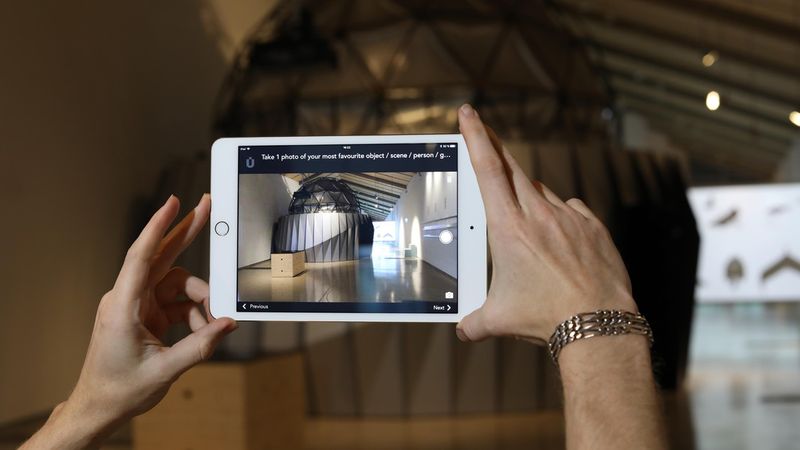Data-driven app brings 'voice of the visitor' to museum experiences
The tool provides visitors with an engaging way to communicate their experiences, while helping museums to consider this feedback when developing exhibits and other attractions.

Users can snap photos or make audio recordings to describe the impact an exhibition had on them © Sarah Kenderdine
EPFL’s Laboratory for Experimental Museology (eM+), led by Sarah Kenderdine, has received support from Engagement Migros to produce muse, a pioneering audience evaluation app, in collaboration with over 20 Swiss museums. The tool provides visitors with an engaging way to communicate their experiences, while helping museums to consider this feedback when developing exhibits and other attractions.
Encouraging audiences to participate in evaluations in large enough numbers to provide useful data is notoriously difficult, and for good reason: respondents may find the process time-consuming or boring. But what if you were invited to communicate your experience at a museum exhibit by making drawings, leaving voice recordings, interacting with animated graphics, or taking photos?
This is the aim of muse: a design-led audience evaluation app that helps museums get to know their visitors better. In addition to geographic and demographic information, the tablet-based tool uses some 30 interactive elements to collect qualitative, subjective data about museum visitors’ experiences.
Capturing experiences
Sarah Kenderdine leads the eM+ lab in EPFL’s College of Humanities. She explains that in Switzerland, as in many parts of the world, museums usually collect only basic demographic data from their visitors, such as number of entries and origin. The goal of muse is therefore to give museums access to data analytics tools that can help them focus on many visitors as individuals, and to use the quality of visitor engagement as a method to define, measure, and program for improved museum experiences.
“It is the social, political, emotional, educational, and creative elements, in addition to how deeply people are participating in a museum’s programs and exhibitions, that should be the basis for measuring value,” Kenderdine says.
Unlike a traditional audience evaluation or survey, visitors use muse to record their experiences as they pass through an exhibit, rather than afterward.
“Muse is always meant to be deployed inside the space of experience, and not afterward, so people can reflect in real time on what their reactions to it really are. Simultaneously, museum staff can see aggregated results on a real-time dashboard,” says Kenderdine, who has been developing muse since 2012.
She notes a recent example of the success of the muse model, when a previous version of the app was deployed for the Winter at Tantora arts festival in AlUla, Saudi Arabia. It engaged 6,000 respondents across five surveys with 120 data points, resulting in 1,200 pages of reports.
“This data provided a phenomenal insight into customer loyalty, future planning, and creative responses to the cultural offering at this new world heritage destination.”
With the support of Engagement Migros, and the participation of more than 20 museums across Switzerland, Kenderdine’s goal now is to bring muse to the next level, including more sophisticated analysis driving better public outcomes for museums and their audiences. The project will be officially launched on September 17th, 2020 at EPFL’s ArtLab.
Looking ahead
At first, the muse team will partner with eight ‘core’ museums and institutions for a three-year period, including: the Château de Morges (Morges), the Haus der Elektronischen Künste (Basel), the International Red Cross Museum (Geneva), the Musée d'Éthnographie (Geneva), the Museum für Gestaltung (Zürich), the Rietberg Museum (Zürich), and the Olympic Museum (Lausanne). Each institution will be supported by an administration portal for creating questions and surveys, an app for collecting data, and a dashboard for visualizing the data in real time. A further 16 museums will be invited to join the project through an open call starting in late 2020.
Throughout the four-year funding period, the muse team will develop convincing case studies for the Swiss museum landscape. It will also explore options for commercializing the app and its licensing models, and for expanding to include all cultural offerings across Europe and beyond – all in close collaboration with its partners.
“With its user-centric approach, muse supports museums in their efforts to continue being active places in society,” says Johanna Muther, Project Manager at Engagement Migros.
Kenderdine adds that going forward, muse will also help museums to increasingly embrace their audiences with renewed attention as they adapt to the challenges of the coronavirus pandemic. “Visitors are active participants, and not just consumers, in helping to support museums as polyvocal places. Muse gives an amplifier to those voices,” she says.
About muse
Muse is the voice of the visitor. In addition to quantitative data, such as geographic and demographic information, the tool can also be used to collect qualitative findings on the direct impact of an exhibition visit. The focus of the app is on creating playful interactions, and on being easy to use – for museums and visitors alike. Museums can use the findings to take greater account of the perspective of visitors when curating and developing their exhibits, thus helping them to remain firmly established as active places in society, both now and in the future.
About Engagement Migros
The Engagement Migros development fund enables pioneering projects in the midst of social change, which break new ground and test solutions aimed at the future. This approach is oriented towards making a difference and combines financial support with coaching services in its Pioneerlab. Engagement Migros is made possible by the companies of the Migros Group thanks to annual funding of approximately CHF 10 million; it has been complementing the Migros Culture Percentage since 2012.